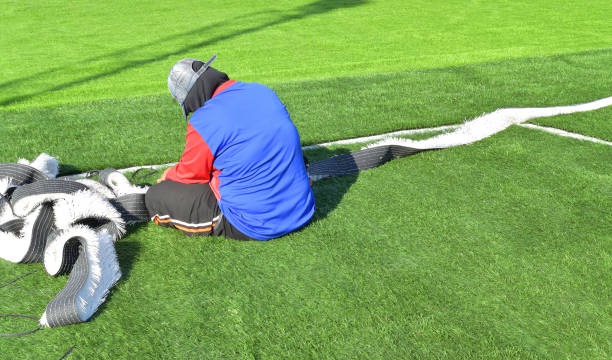Artificial turf offers a lush, green lawn year-round without the hassle of mowing, watering, or fertilizing. But to keep it looking its best and prolong its life, you still need to perform some regular maintenance. Don’t worry, though; the upkeep is simple if you know the right steps.
Why Maintenance Matters
Caring for your artificial grass is essential to maintaining its aesthetics and functionality. Proper maintenance enhances the turf’s durability, prevents unpleasant odors, and keeps it free from dirt and debris. With the right care, a well-maintained lawn can last anywhere from 15 to 20 years or even longer.
Regular Cleaning Routine
Simple Steps for Cleaning
-
Rinse Weekly: Use a garden hose to rinse your turf weekly. This removes dust and pollen, keeping your lawn clean and vibrant.
-
Monthly Deep Clean: Once a month, use a soft-bristled brush to scrub the turf fibers. Brush against the grain to make them stand upright and avoid matting.
A tip to consider is using a turf cleaner specifically designed for synthetic grass. Such a product helps remove stains and keep the grass fresh without causing damage.
Keep It Free from Debris
1. Remove Leaves and More
Fallen leaves, twigs, and trash can accumulate quickly on your turf. Regularly using a leaf blower or a rake will help keep your lawn clean. Remember to use a plastic rake to avoid damaging the synthetic fibers.
2. Combat Weeds
Even though artificial turf resists weeds, they can still sneak through. Keep an eye out and remove them by hand, or apply a weed killer if needed.
Dealing with Stains and Spills
1. Swift Action Plan
Accidents happen. Whether it’s a ketchup spill from a backyard barbecue or a pet’s little mishap, addressing them quickly prevents long-term stains. Use mild soap and water to clean the area, followed by a thorough rinse.
2. Stubborn Stains
For tougher stains like oil or grease, a stronger solution may be necessary. A mixture of vinegar and water or laundry detergent should do the trick. Always test on a small area first to ensure no discoloration occurs.
Pet Owners Guide
Pet Waste Management
If you have pets, their waste can be the biggest challenge. Remove solid waste as soon as possible and hose down the affected area with water. Using the services of professionals, such as a turf cleaner in Queen Creek, can help neutralize any lingering odors, making your lawn more pleasant.
Grooming Your Turf
1. Brushing Regularly
Regular brushing helps maintain the grass’s upright appearance. Aim to brush your turf every month using a broom or a power brush. This keeps the fibers from becoming matted and enhances their resilience.
2. Handle High-Traffic Areas
High-traffic zones can result in noticeable flattening. In these cases, more frequent brushing and added infill might be necessary to keep the turf looking and performing well.
Weather and Your Turf
Adapting to Seasons
Your artificial turf is generally weather-resistant. However, in extreme conditions, it can require special attention. During hot summers, rinsing the turf to cool it down can prevent damage. In the winter, while snow doesn’t harm the turf, using a plastic shovel can help remove heavy snowfall without damaging the fibers.
Ensuring Proper Drainage
1. Avoid Water Pooling
Drainage is crucial for preventing water pooling and the growth of mildew. Regularly check the drainage system under the turf for blockages and ensure that water flows smoothly away from your property.
2. Adjustments as Needed
If you notice standing water, you should adjust the base layer beneath the turf. Consult with a professional for optimal results.
Protect from Heavy Objects
1. Prevent Indentations
When placing furniture or heavy objects on the turf, use pads or barriers to disperse the weight. This prevents indentations that could harm the grass’s appearance.
2. Move Items Regularly
Occasionally, moving furniture ensures one area doesn’t bear all the weight, reducing the risk of permanent damage to the grass.
Investing in Protective Measures
For long-lasting beauty, products similar to Dino Shield Total Turf Protection can be a wise investment. Such protective measures provide added resilience and safeguard against wear and tear, ensuring your turf remains pristine for years.
Protecting from UV Rays
Guard Against Fading Artificial turf is designed to withstand sunlight, but prolonged exposure to UV rays can still lead to fading over time. To minimize this:
-
Use UV-Protective Coatings: Apply a UV-protective coating to shield turf fibers from sun damage. These coatings can be sprayed on and help maintain the vibrant color of your lawn.
-
Install Shade Structures: Consider adding pergolas, shade sails, or umbrellas to areas of your lawn that receive intense sunlight. This will not only protect your turf but also provide a comfortable space for outdoor activities.
By incorporating these additional protection measures, you enhance the longevity and appearance of your artificial turf, ensuring it remains vibrant and lush for many years.
Final Thoughts
Maintaining artificial turf doesn’t have to be overwhelming. By following these straightforward tips, you’ll enjoy a beautiful green lawn year-round with minimal effort. From regular cleaning to addressing high-traffic zones and weather-related challenges, these steps will keep your artificial grass looking as good as new. With the right care, your turf can remain a vibrant, welcoming part of your outdoor space for years to come.
